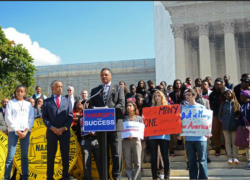
The Supreme Court entertained oral arguments Wednesday morning in a case that could redefine the way affirmative action is used in America. At stake is not only the fate of diversity programs nationwide, but also the precedents set by U. Michigan in the landmark cases Gratz v. Bollinger and Grutter v. Bollinger.
Attorneys faced pointed questions from the justices, as the sharply divided court wrestles with how to address the claim brought forth by Abigail Fisher, a white Texan who was denied admission to the University of Texas, which uses race-based admissions practices.
During questioning, Justice Sonia Sotomayor laid out the central question facing the court as it decides whether race should be considered in university admissions.
“When do we stop deferring to the university’s judgment that race is still necessary?” Sotomayor said. “That’s the bottom line of this case.”
In 2003, the Supreme Court attempted to create a framework whereby higher education institutions could use affirmative action within certain bounds. In Gratz v. Bollinger, the justices determined that an automatic awarding of points or preferential admissions based solely on race was not legal. However, in the companion case Grutter v. Bollinger, Justice Sandra Day O’Connor wrote in her majority opinion that race could be considered on a holistic basis with regard to how much an individual could bring to campus diversity.
Attorneys from U. Texas, which is defending its admissions practices faced pointed questions from Justice Antonin Scalia, Justice Samuel Alito, and Chief Justice John Roberts — the court’s conservative leaning members.
Bert Rein, Fisher’s attorney, said he didn’t want the court to overturn Grutter, but rather force the court to better define how universities could use race as a factor in admissions. He argued that Texas’s use of affirmative action didn’t meet Grutter’s requirements because its policy to grant automatic admission to the top 10 percent of students at every Texas high school provided enough diversity.
“You don’t want to overrule Grutter,” Sotomayor said. “You just want to gut it.”
Justice Anthony Kennedy, considered to be the potential swing vote in the case, didn’t appear to tip his hand during the debate, questioning both sides.
Kennedy challenged one of U. Texas’ attorneys after he argued that the school wanted to consider race in admissions in order to attract students outside the top 10 percent of each high school’s graduating class.
“What you’re saying, is that race counts above all,” Kennedy said.
The case is widely expected to be a victory for Fisher in some form. However, the way in which she prevails will determine the case’s legacy in future considerations. Should the court rule that what U. Texas was doing with the combination of the ten percent plan and additional race exceeded its mandate under Grutter, but provides a better definition for how diversity goals should be achieved, affirmative action will largely stand.
Still, it’s also possible that the conservative justices who now dominate the court could overturn the precedent set by Grutter and eliminate the consideration of race altogether in college admissions.
Further changing the composition of the court was Justice Elena Kagan’s decision to recuse herself from the case. Though no official explanation was provided, it is likely because she worked on related issues during her time as United States Solicitor General. Justice Kagan usually votes with the liberal side of the court, which makes the University of Texas’ case more difficult to win.
Should the court split 4-4, the lower circuit court’s decision that the actions of the University of Texas are legal under Grutter would stand, but would not have any precedential value.
